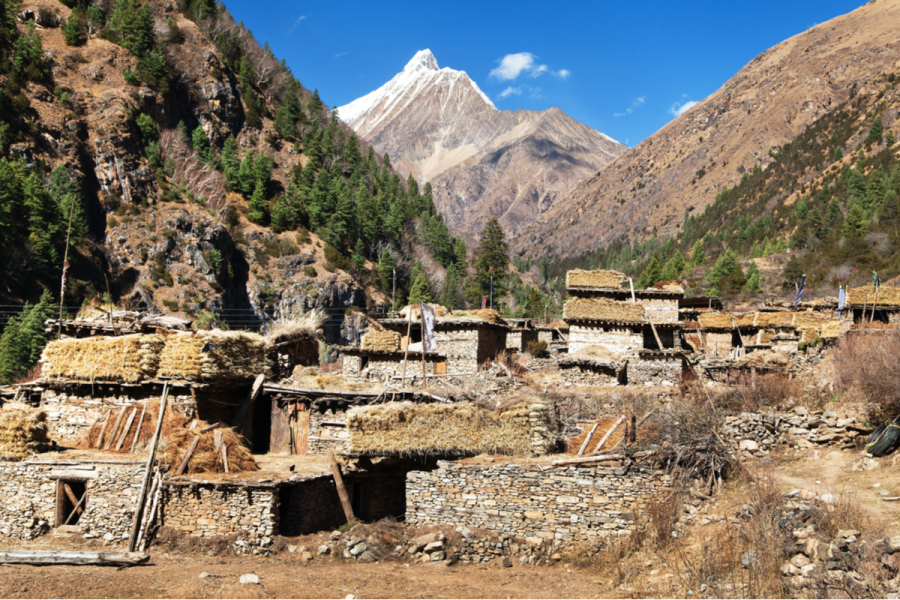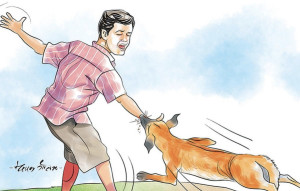Columns
Seeking solutions from within
We need to embrace indigenous knowledge for biodiversity conservation.
Sunita Chaudhary & Biraj Adhikari
Nature is an essential part of our identity and life. The best examples of harmonious and beneficial co-existence with nature come from places where nature is valued and respected as an essential part of people’s identity and life. Sacred valleys in the Himalaya, called beyul, have special significance in Tibetan Buddhism. Local Buddhist communities believe that the physical and spiritual worlds overlap in beyul, which is why they have been preserving environments in such valleys for centuries. Similarly, the indigenous Gond people from central India hold an intimate relationship with nature, believing that spirits preside in nature’s different forms. They preserve patches of forests—designated as sacred groves—with deep spiritual fervour. Today, these lands are among the last remaining patches of forests left unspoiled in the region.
These and many other indigenous tribes from around the world have been custodians of nature for centuries, protecting their landscapes, biodiversity, and ecosystems for the benefit of future generations. Thirty-five percent of protected areas across the world fall within indigenous territories, and these areas have been found to be more successful in conservation than others, mostly because of the practices and beliefs of indigenous people.
Indigenous knowledge as a solution
There are countless examples of success stories of indigenous communities around the world providing solutions for environmental issues such as soil degradation, pest and disease control, desertification, climate change, and water shortage. In Nepal too, indigenous knowledge, beliefs, and traditional practices have influenced better land-use practices, sustainable use of resources, and enhanced biodiversity conservation.
For example, the Chepang community believes that holy spirits reside in plants, animals, rivers, and mountains, so they extract resources sustainably, following strict tradition. Likewise, the Pungmo community from Dolpo valley follows the animist worldview of the Bon religion, which teaches them the intimate relationship between nature and livelihoods. Such beliefs, along with traditional knowledge and informal social mechanisms passed down from generations, contribute to maintaining genetic diversity in farmlands, regeneration of grasslands, protection of forests, and sustainable management of natural resources. The discourse is even more important at this time because various demographic, social, economic, and political factors are further pushing these systems to the margins.
Communities sidelined
Around the world, indigenous communities are facing increasing challenges of lack of recognition of their collective rights to land, discrimination and poverty. Indigenous communities also reside in regions that are most vulnerable to the effects of climate change and are therefore exposed to food insecurity, extreme events, increased pests and diseases, and acute water shortages. Furthermore, many mainstream protected area approaches have negatively impacted indigenous people as conservation norms and regulations may require their relocation, thereby affecting their livelihoods.
Nepal’s indigenous communities have also faced these challenges. The Sonaha fishing community of Bardiya, Kailali, and Kanchanpur districts have had their land access, livelihoods, and culture deeply impacted by sanctions imposed by national parks; Chepang communities have frequently been vulnerable to hazards and climate-induced disasters; the indigenous communities in the far west had to forfeit their customary rights and access to natural resources when the Shuklaphanta wildlife reserve was established.
Other socioeconomic factors have further burdened indigenous groups. For example, new economic opportunities in urban areas have led to out-migration of youth from villages in the Tarai and the abandonment of knowledge on wild and cultivated plant diversity and plant knowledge has been declining over generations in Baitadi and Darchula districts because of socio-cultural and economic transformations in the region. Such challenges have been collectively leading to the loss of observations, interpretations, and knowledge, adopted and enriched over time and passed down by our ancestors over many generations.
A shifting tide
But this disregard of indigenous knowledge is changing. The recognition of indigenous peoples as custodians of land and keepers of valuable knowledge has slowly started growing. The Intergovernmental Platform for Biodiversity and Ecosystem Services (IPBES), an international body established to develop and present evidence-based knowledge for policymakers in biodiversity conservation, has highlighted the importance of diverse worldviews and stakeholders to value nature, including both scientific knowledge and indigenous and local knowledge systems. For this, the IPBES has developed the concept of nature’s contributions to people (NCP) to synergise both knowledge realms and provide an inclusive picture of human-nature relations.
The 2019 global assessment report by IPBES, one of the most comprehensive reports on biodiversity and ecosystem services, has also included a substantive body of indigenous and local knowledge. Further, ‘Supporting Identities’, one of the 18 NCPs introduced by the IPBES, explicitly takes into account the relationship between indigenous groups and nature that co-produces important values and services for wellbeing.
The Sustainable Development Goals (SDGs) provide a tremendous opportunity for the further protection and recognition of indigenous peoples and their knowledge. Over the world, 193 countries have made commitments to prioritise the most vulnerable populations, including indigenous people, in development. In fact, indigenous knowledge systems have been increasingly found to be important for the advancement of multiple SDGs.
In Nepal, many studies have implicitly found that traditional and local knowledge can contribute towards multiple goals—locals from Bonch in Dolakha collect and consume wild foods to fulfil their nutritional requirements (SDG 2); indigenous communities in the far west without access to modern health facilities use wild medicinal plants to treat ailments (SDG 3); the spiritual beliefs of locals from Maipokhari have helped keep the lake free of pollution (SDG 6). More importantly, indigenous knowledge on farming, soil conservation, and water use efficiency has been important in many cases for climate change adaptation (SDG 13). Furthermore, animistic and spiritual views have been instrumental for the sustainable consumption of resources (SDG 12) and the conservation of biodiversity (SDG 15) in Nepal.
Vexed by the looming problems of climate change and challenged by the complexities in meeting the SDGs, we have forgotten the knowledge that has been passed down over generations. We and the knowledge we harbour have been part of the solution all along. We just needed to look inwards to observe the seeds of knowledge planted by our forefathers and ancestors. It is high time that we co-create solutions to the environmental problems in Nepal by combining traditional knowledge with scientific knowledge. After all, humans are kin to nature, and naturally, we are part of the solution.




 10.12°C Kathmandu
10.12°C Kathmandu
















